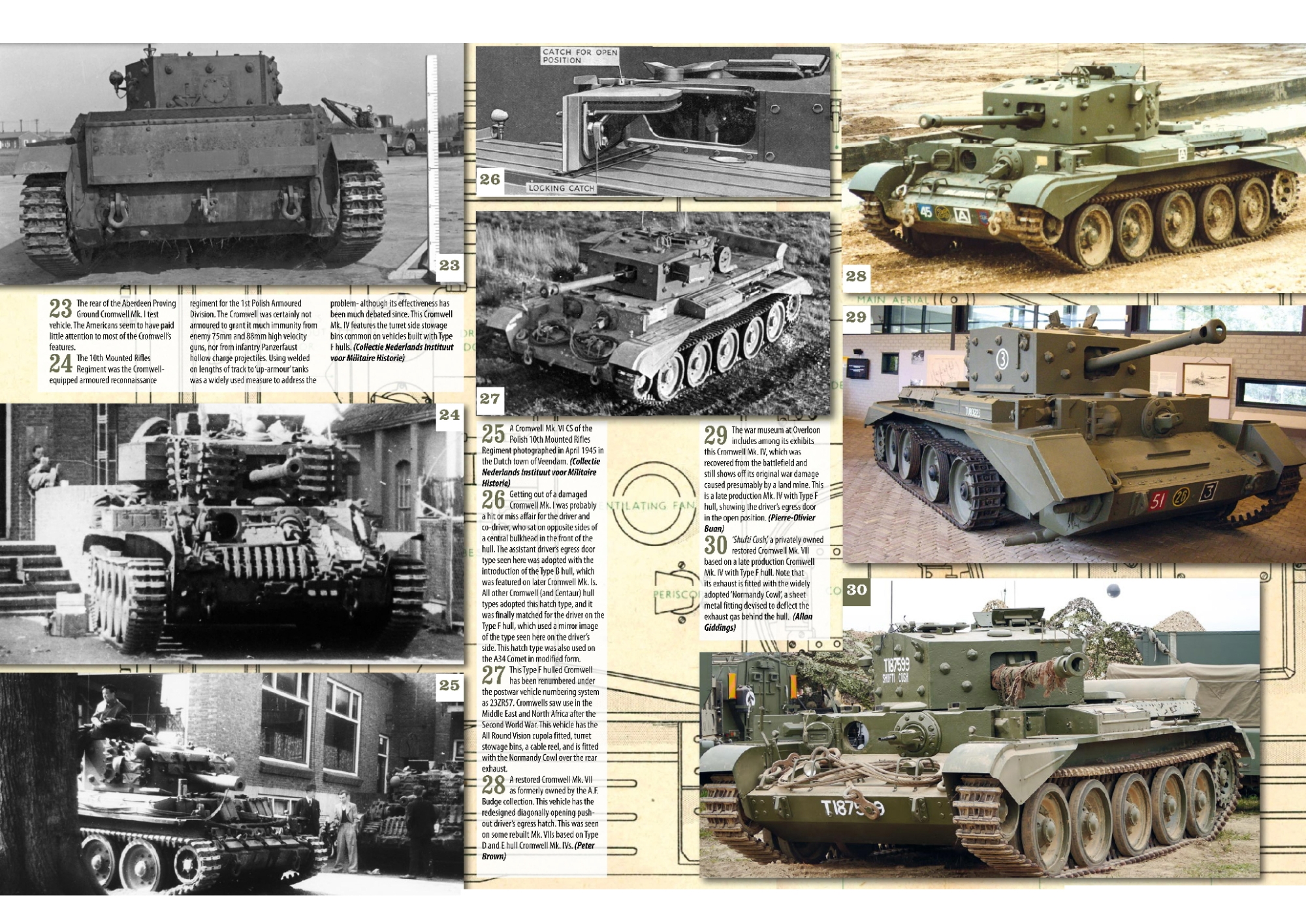
VARIANTS
Cromwell I: Original production model with 6pdr gun. Similar in external appearance to Centaur I.
Cromwell II: Mk I modified by removal of hull machine gun and fitting of wider tracks-15tin in place of 14in.
Cromwell III: Centaur I re-engined with Meteor to bring it to A27M standards. Originally designated Cromwell X.
Cromwell IV: Centaur III with 75mm gun re-engined with Meteor.
Cromwell IVw: As Mk IV but with all-welded hull, and built with Meteor engine.
Cromwell Vw: As Mk IV but with all-welded hull.
Cromwell VI: As Mk IV but with 95mm howitzer replacing the 6pdr for the close support role.
Cromwell VII: Cromwell IV re-worked with applique armour welded on hull front, 15 ½ in tracks replacing 14in tracks, stronger suspension, and reduced final drive ratio to govern down maximum speed to 32mph.
Cromwell VIIw: Cromwell Vw modified as above.
Cromwell VIII: Cromwell VI modified as above.
Cromwell ARV: Vehicle with turret removed, winch fitted in turret space, and demountable A-frame jib. Appearance as Centaur ARV.
Cromwell Command/OP: Mk IV, VI or VIII fitted with dummy gun and extra radio equipment for use of formation commander or artillery observation officers.
Cromwell CIRD: Vehicle with fittings to take Canadian Indestructible Roller Device (CIRD) mine exploding equipment. Few only converted.
Cromwell “Prong”: Standard vehicle fitted with Cullin Hedgerow Cutting Device, Normandy 1944. This equipment, at first, extemporised in the field, then manufactured in limited quantities, was fitted to some Cromwell and Sherman tanks in June-August 1944 to assist in breaking through the extensive hedges and foliage of the “Bocage” country of Normandy which otherwise tended to restrict movement to the roads.
Charioteer: Post-war (1950) conversion of existing Cromwell chassis with new turret and 20pdr gun. Several experimental or trials models of Cromwells were produced to test installations or proposed modifications. Three of these are illustrated. Also projected was a Cromwell Crocodile, still under development at the war’s end. It was similar to the Churchill Crocodile.
| Specifications | |
|---|---|
| Mass | 27.6 long tons (28.0 t) |
| Length | 20 ft 10 in (6.35 m) |
| Width | 9 ft 6 1⁄2 in (2.908 m) |
| Height | 8 ft 2 in (2.49 m) |
| Crew | 5 (Commander, gunner, loader/radio operator, driver, hull gunner) |
| Armour | 3 inches (76 mm) on Mk.IV, 4 inches (100 mm) on Mk.V |
| Main armament |
Ordnance QF 75 mm with 64 rounds |
| Secondary armament |
2 x 7.92 mm Besa machine gun with 4,950 rounds |
| Engine | Rolls-Royce Meteor V12 petrol 600 hp (450 kW) |
| Power/weight | 21.4 hp (16 kW) / tonne |
| Transmission | Merritt-Brown Z.5 gearbox (five forward and one reverse gear) driving rear sprockets |
| Suspension | Improved Christie |
| Ground clearance | 16 inches (410 mm) |
| Fuel capacity | 110 imp gal (500 l) + optional 30 imp gal (140 l) auxiliary |
| Operational range |
170 miles (270 km) on roads, 80 mi (130 km) cross country[3] |
| Maximum speed | 40 mph (64 km/h) with 3.7:1 final reduction drive |